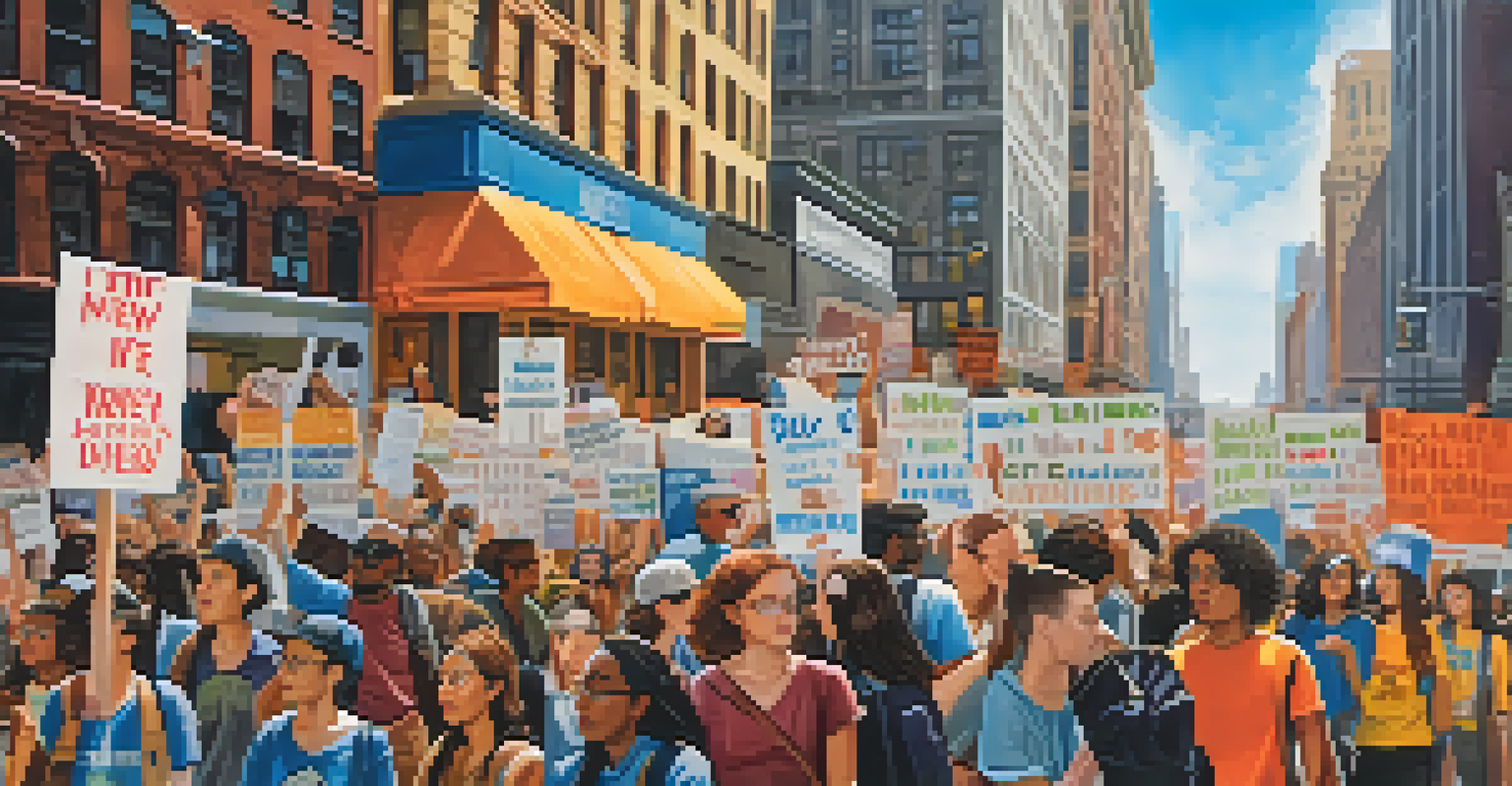Environmental Justice: NYC Activism for a Greener Future

Understanding Environmental Justice in NYC
Environmental justice is the fair treatment of all people, regardless of race, color, or income, when it comes to environmental laws and policies. In NYC, this means addressing the disproportionate impact of pollution and climate change on marginalized communities. Activists argue that everyone deserves a healthy environment, and they're working hard to make that a reality.
Environmental justice is not a separate issue from social justice; it is a crucial part of it.
Historically, low-income neighborhoods and communities of color have faced the brunt of environmental hazards. From air pollution to waste management issues, these areas often lack the resources to combat these challenges. This inequity is what drives many activists to fight for change, advocating for policies that protect all residents equally.
In recent years, the conversation around environmental justice has gained momentum, with more people recognizing the connections between social justice and environmental health. As NYC continues to grow, the need for sustainable solutions that prioritize all communities has never been more urgent.
Grassroots Movements Leading the Charge
Grassroots movements in NYC have become instrumental in the fight for environmental justice. Organizations like WE ACT for Environmental Justice and the New York City Environmental Justice Alliance mobilize community members to advocate for cleaner air and sustainable development. These groups often work from the ground up, addressing local issues and empowering residents to make their voices heard.

One powerful example is the push for improved public transportation to reduce emissions in heavily polluted areas. Activists organize community forums and rallies, ensuring that local voices shape the conversation around transportation and air quality. Their efforts highlight how community-driven initiatives can lead to significant policy changes.
Activism Drives Environmental Justice
Community activism in NYC has led to significant policy changes aimed at promoting environmental justice and addressing the needs of marginalized communities.
These movements not only address immediate environmental concerns but also foster a sense of community and solidarity among residents. By working together, they create a network of support that strengthens their fight for a greener, healthier city.
Policy Changes Driven by Activism
Activism in NYC has led to several policy changes aimed at promoting environmental justice. Initiatives like the Climate Leadership and Community Protection Act prioritize investments in disadvantaged communities, ensuring they receive the support needed to combat climate change. This kind of legislation is crucial for creating equitable solutions that benefit all residents.
The future will be green, or not at all.
Another significant development is the city’s commitment to 100% renewable energy by 2040, which is a direct response to the demands of activists. By transitioning to clean energy, NYC aims to reduce greenhouse gas emissions and improve air quality, especially in neighborhoods most affected by pollution. This ambitious goal is a testament to the power of community advocacy.
Moreover, the city has begun to integrate environmental justice considerations into its planning processes. This means that future developments will be evaluated not just for their economic impact but also for their potential effects on local communities, ensuring that everyone has a say in the city's future.
Youth Engagement in Environmental Justice
Young people in NYC are increasingly taking the helm in the environmental justice movement. Through organizations like Fridays for Future and local youth councils, they are raising awareness and demanding action on climate issues. Their passion and energy bring fresh perspectives, reminding older generations of the urgency of these challenges.
Youth-led protests and campaigns have gained significant media attention, showcasing the power of social media in mobilizing support. By using platforms like Instagram and TikTok, young activists reach broader audiences, inspiring peers and adults alike to join the fight for a greener future. Their creativity and determination are reshaping the narrative around environmental issues.
Youth Engagement is Crucial
Young people are taking a leading role in the environmental justice movement, using social media to raise awareness and inspire action on climate issues.
Additionally, many schools are incorporating environmental education into their curriculums, empowering students to understand the impact of their choices. This educational approach fosters a sense of responsibility and encourages the next generation to be stewards of the environment, ensuring that the fight for justice continues.
The Role of Local Government
Local government plays a critical role in advancing environmental justice in NYC. Through initiatives like the OneNYC plan, city leaders are committing to equitable and sustainable policies. This comprehensive approach addresses issues ranging from waste management to renewable energy, demonstrating that environmental justice is a citywide priority.
Collaboration between local agencies and community groups is essential for effective policy implementation. By involving residents in decision-making processes, local government can better understand the needs of different communities. This inclusive approach helps to build trust and ensures that solutions are tailored to the unique challenges faced by each neighborhood.
Moreover, NYC’s commitment to transparency in environmental data allows residents to monitor pollution levels and advocate for necessary changes. Access to information empowers communities, making it easier for them to hold their leaders accountable and push for the changes they want to see.
Community Resilience and Sustainability
Building resilience in communities is a key aspect of achieving environmental justice in NYC. Initiatives aimed at enhancing green spaces, such as parks and community gardens, not only improve air quality but also provide essential recreational areas for residents. These green spaces serve as vital resources for community health and well-being.
Sustainable practices like urban farming and composting are gaining traction in various neighborhoods, promoting local food production and reducing waste. By engaging residents in these practices, communities become more self-sufficient and connected to their environment. This fosters a sense of ownership and pride in their surroundings.
Local Government's Role is Vital
Effective collaboration between local government and community groups is essential for implementing equitable and sustainable environmental policies in NYC.
Furthermore, educational programs focused on sustainability help equip residents with the knowledge and skills to live greener lives. Workshops on topics like energy conservation and waste reduction empower individuals to make informed choices, creating a ripple effect that benefits the entire community.
Future Challenges and Opportunities
While NYC has made significant strides in environmental justice, challenges remain. Climate change continues to pose threats, particularly to vulnerable neighborhoods that may not have the resources to adapt. As the city faces rising sea levels and increased flooding, it’s crucial to prioritize these communities in future planning.
Moreover, the intersection of social and economic issues complicates the fight for environmental justice. Issues like housing affordability and access to healthcare also impact residents' ability to advocate for a healthier environment. Addressing these interconnected challenges requires a holistic approach that considers the multifaceted nature of justice.

However, these challenges also present opportunities for innovation and collaboration. By fostering partnerships between community organizations, local government, and businesses, NYC can develop comprehensive solutions that not only address environmental issues but also promote social equity. The future of environmental justice in NYC depends on continued activism and collaboration across all sectors.